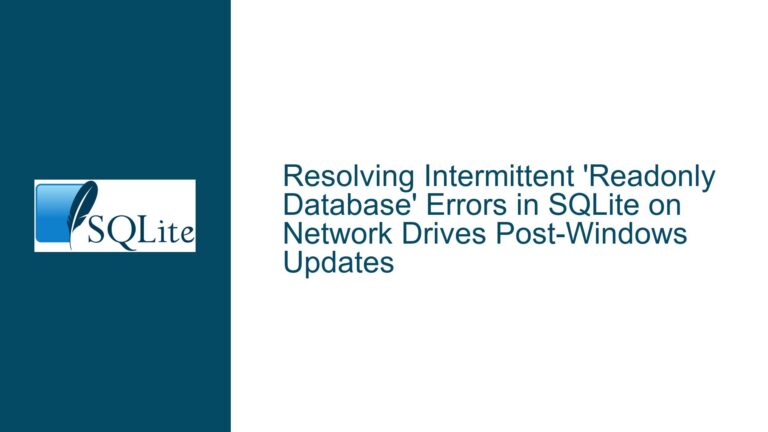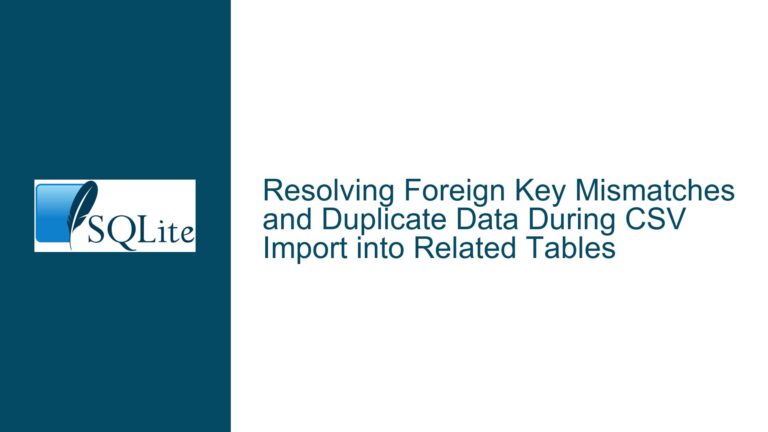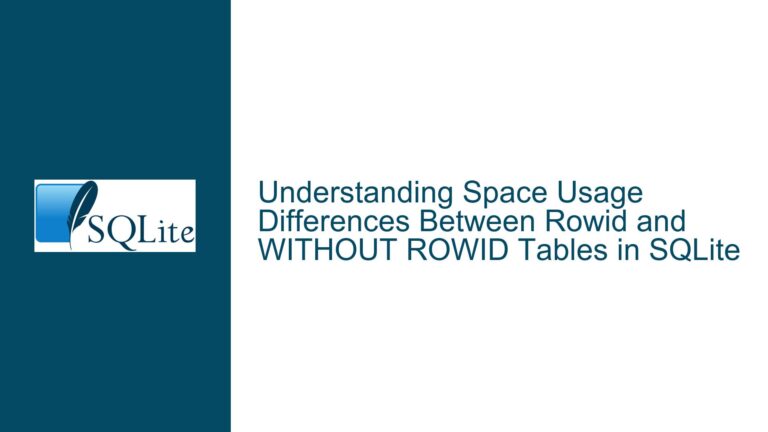Rowid Behavior in SQLite Views and Table Indexes
SQLite Views and the Misconception of Rowid Presence
The core issue revolves around the confusion regarding whether SQLite views can inherently possess a rowid, a concept typically associated with tables. A rowid in SQLite is an implicit integer primary key that uniquely identifies each row in a table. However, views, being virtual tables that do not store data themselves, do not inherently have a rowid. The confusion arises when a view appears to have a rowid, which is often due to the underlying query of the view rather than the view itself.
The misunderstanding is further compounded by the use of a specific SQLite pragma function, pragma_index_info, which is designed to retrieve information about the columns in an index. When applied to a view, this function can return unexpected results, leading to the erroneous conclusion that the view has a rowid. This behavior is not a bug but rather a consequence of the nature of views and the specific pragma function being used.
Misapplication of pragma_index_info on Views
The primary cause of the confusion is the misapplication of the pragma_index_info function on views. This function is intended to be used with tables, specifically to retrieve information about the columns in an index. When applied to a view, the function does not behave as expected because views do not have indexes in the same way that tables do. The function may return a result that suggests the presence of a rowid, but this is a misinterpretation of the function’s output.
The pragma_index_info function works by querying the internal SQLite data structures that store index information. When applied to a table, it correctly returns information about the index columns. However, when applied to a view, the function may return a result that is not meaningful, as views do not have the same underlying data structures as tables. This can lead to the false impression that the view has a rowid.
Another contributing factor is the naming of columns in the underlying query of the view. If the query that defines the view includes a column named rowid, this can further confuse the issue. The presence of a column named rowid in the view’s result set does not mean that the view has a rowid in the same sense as a table. It simply means that the view’s query has a column with that name.
Correct Usage of pragma_index_info and Understanding Views
To resolve the confusion, it is essential to understand the correct usage of the pragma_index_info function and the nature of views in SQLite. The pragma_index_info function should only be used with tables, as it is designed to retrieve information about the columns in an index. When applied to a view, the function’s output is not meaningful and should not be interpreted as indicating the presence of a rowid.
When working with views, it is important to recognize that they are virtual tables that do not store data themselves. The data displayed by a view is derived from the underlying tables through the view’s defining query. As such, views do not have a rowid in the same sense as tables. If a view appears to have a rowid, it is because the underlying query includes a column with that name, not because the view itself has a rowid.
To avoid confusion, it is recommended to use the pragma_index_info function only with tables and to be cautious when interpreting its output. When working with views, it is important to examine the underlying query to understand the source of any columns that may be named rowid. This will help to avoid the misconception that views have a rowid in the same sense as tables.
In summary, the confusion regarding the presence of a rowid in SQLite views stems from the misapplication of the pragma_index_info function and a misunderstanding of the nature of views. By using the pragma_index_info function correctly and understanding the differences between tables and views, it is possible to avoid this confusion and work effectively with both tables and views in SQLite.
Detailed Analysis of pragma_index_info and Views
To further clarify the behavior of the pragma_index_info function when applied to views, let’s delve into the technical details of how this function works and why it behaves differently with views compared to tables.
How pragma_index_info Works with Tables
When applied to a table, the pragma_index_info function retrieves information about the columns in an index. This information is stored in the internal SQLite data structures that manage indexes. The function returns a result set that includes details such as the column name, the column’s position in the index, and whether the column is sorted in ascending or descending order.
For example, consider a table employees with an index on the last_name column. The following query would retrieve information about the index:
SELECT * FROM pragma_index_info('employees_last_name_idx');
This query would return a result set that includes details about the last_name column in the index, such as its position and sort order.
How pragma_index_info Behaves with Views
When applied to a view, the pragma_index_info function does not behave as it does with tables. Views do not have indexes in the same way that tables do, as they do not store data themselves. Instead, views are defined by a query that retrieves data from one or more underlying tables.
Consider a view employee_names that is defined by the following query:
CREATE VIEW employee_names AS
SELECT first_name, last_name FROM employees;
If we attempt to use the pragma_index_info function on this view, the result is not meaningful:
SELECT * FROM pragma_index_info('employee_names');
This query may return a result set, but it does not provide useful information about the view’s columns. The function is not designed to work with views, and its output should not be interpreted as indicating the presence of a rowid or any other index-related information.
The Role of Column Names in Views
One source of confusion is the naming of columns in the underlying query of a view. If the query that defines the view includes a column named rowid, this can lead to the false impression that the view has a rowid. However, this is not the case. The presence of a column named rowid in the view’s result set does not mean that the view has a rowid in the same sense as a table.
For example, consider a view employee_ids that is defined by the following query:
CREATE VIEW employee_ids AS
SELECT rowid, first_name, last_name FROM employees;
In this case, the view includes a column named rowid, but this column is simply a reference to the rowid of the underlying employees table. The view itself does not have a rowid; it is merely displaying the rowid of the rows in the employees table.
Best Practices for Working with Views and pragma_index_info
To avoid confusion when working with views and the pragma_index_info function, it is important to follow these best practices:
Use
pragma_index_infoOnly with Tables: Thepragma_index_infofunction is designed to retrieve information about the columns in an index. It should only be used with tables, as views do not have indexes in the same way that tables do.Examine the Underlying Query of Views: When working with views, it is important to examine the underlying query to understand the source of any columns that may be named
rowid. This will help to avoid the misconception that views have arowidin the same sense as tables.Avoid Naming Columns
rowidin Views: To prevent confusion, avoid naming columnsrowidin the queries that define views. Instead, use more descriptive names that clearly indicate the source of the data.Understand the Difference Between Tables and Views: Recognize that views are virtual tables that do not store data themselves. The data displayed by a view is derived from the underlying tables through the view’s defining query. As such, views do not have a
rowidin the same sense as tables.
By following these best practices, you can avoid the confusion that arises from the misapplication of the pragma_index_info function and work effectively with both tables and views in SQLite.
Conclusion
The confusion regarding the presence of a rowid in SQLite views stems from the misapplication of the pragma_index_info function and a misunderstanding of the nature of views. By using the pragma_index_info function correctly and understanding the differences between tables and views, it is possible to avoid this confusion and work effectively with both tables and views in SQLite.
In summary, views do not inherently have a rowid, and any appearance of a rowid in a view is due to the underlying query rather than the view itself. The pragma_index_info function should only be used with tables, and its output should not be interpreted as indicating the presence of a rowid in a view. By following best practices and understanding the technical details of how views and the pragma_index_info function work, you can avoid confusion and work effectively with SQLite databases.






